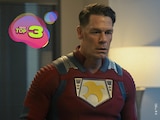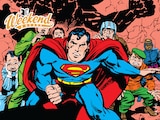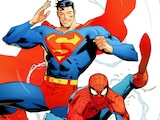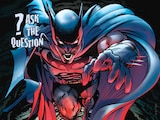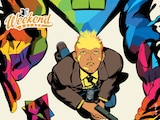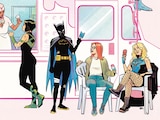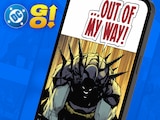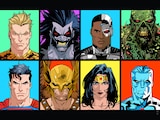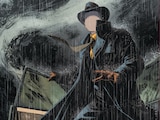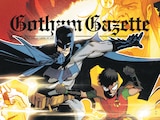Welcome, curious readers, to our 105th edition of ASK…THE QUESTION. I am, as ever, Alex Jaffe, better known to the DC Community as HubCityQuestion. I’m eager as usual to entertain your questions about the breadth of the DC Universe, no matter how granular or obscure. Every day I hold court in the DC Community to take your cases, highlighting and expanding some of my favorites for this column to educate the public on the ephemera of DC continuity and history. Let’s see how this latest crop has grown in.
Villainous Volumes
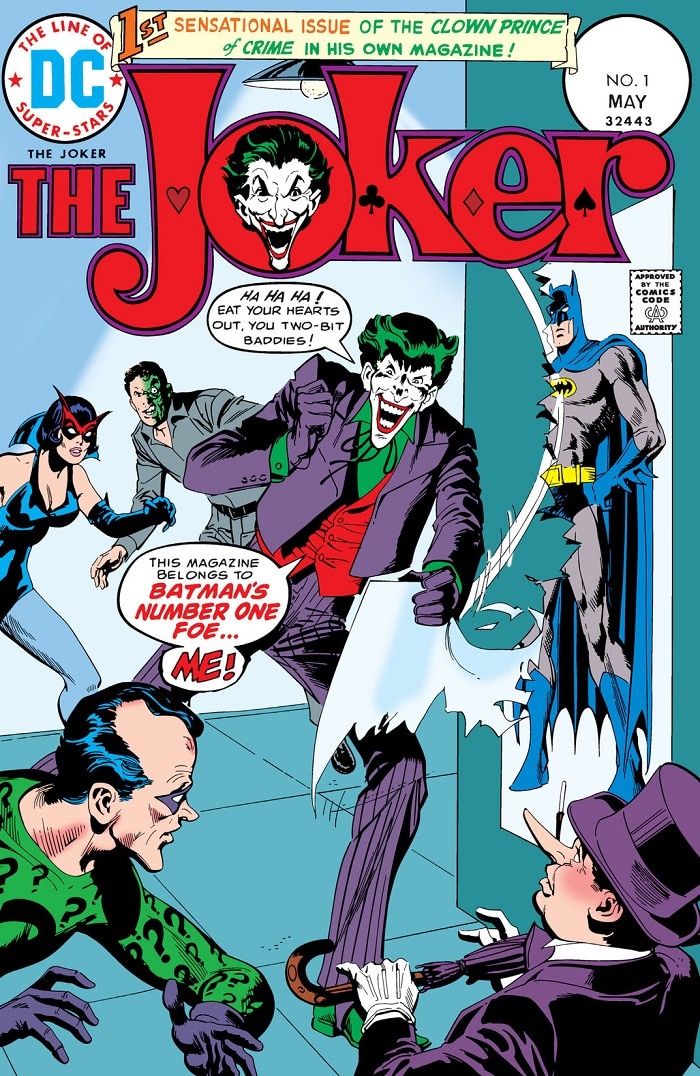
Wrightline1.42741 asks:
In 1975, the Joker pulled a first at DC, gaining a short-lived title of his very own. Since then, many other villains have had their moments in the spotlight with either one-shots or miniseries (with the big exception being Catwoman). Who followed Mr. J with a title?
Since Joker’s nine-issue run back in the ’70s, events like “New Year’s Evil,” “Villains Month” and “Year of the Villain” have periodically ensured that a whole legion of doom-bringing villains have been given their own one-shots or limited series. To focus our scope on this question, we’ll be specifically discussing the villains who, like the Joker, were given the chance to helm their own ongoing series, whether it went the distance or not. Of course, the true nature of villainy, and who philosophically qualifies as a villain, is as fluid as comic continuity itself. So, for the sake of this exercise, we’re going to define a villain as any character who has an established history as an antagonist.
The Joker was technically preceded by Wanted, a reprint anthology collecting villain-showcasing stories from other titles in 1972. This collection ran for nine issues.
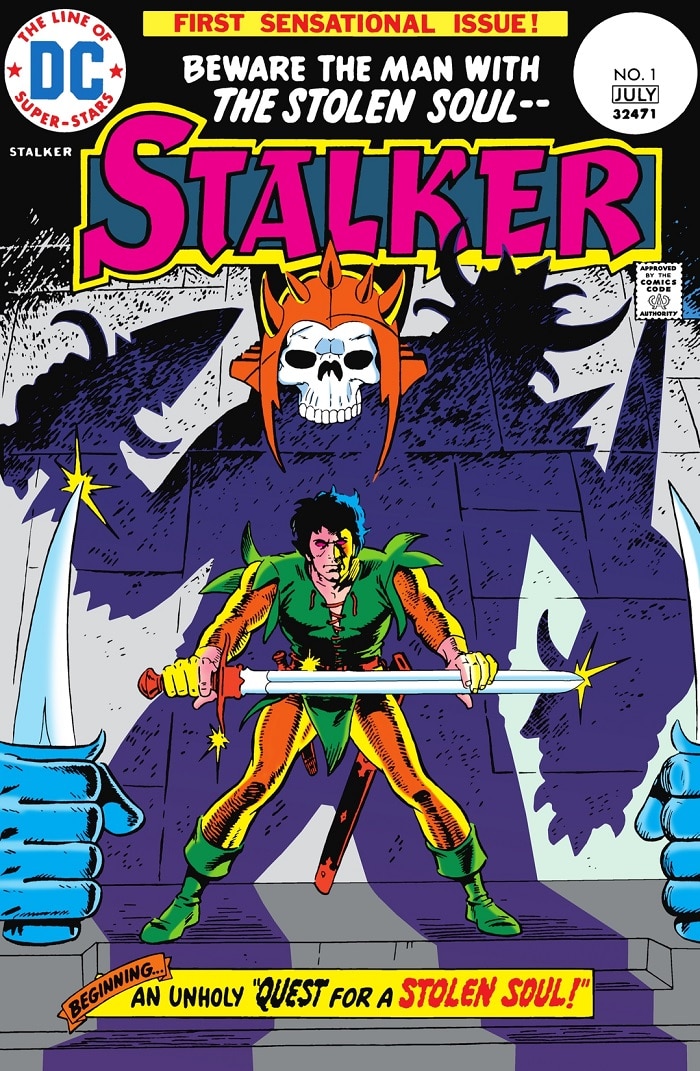
The first villain to get his own series right after the Joker is not one you’d expect—DC’s Stalker the Soulless, a dark fantasy character created by Paul Levitz and Steve Ditko. Stalker lasted just four issues, but you still see him pop up from time to time in sword and sorcery stories.
The next Batman villain after the Joker to get his own treatment for an ongoing series was Kirk Langstrom, the mad scientist who would become Man-Bat. Though it was canceled after two issues.
Man-Bat was followed by Kobra in 1976, another villain who debuted in his own title without first establishing himself with another hero. The series lasted seven issues, and today, Kobra has evolved into a terrorist group that regularly causes trouble for the heroes and agencies of the DC Universe.
DC’s most successful villain title of the 1970s would be 1976’s Secret Society of Super-Villains, featuring a team of villains as the stars for the first time. With an initial lineup of Gorilla Grodd, Copperhead, Captain Cold, Mirror Master, Sinestro, Star Sapphire, Shadow Thief, the Wizard, Captain Boomerang and Manhunter, the series would run for fifteen issues.
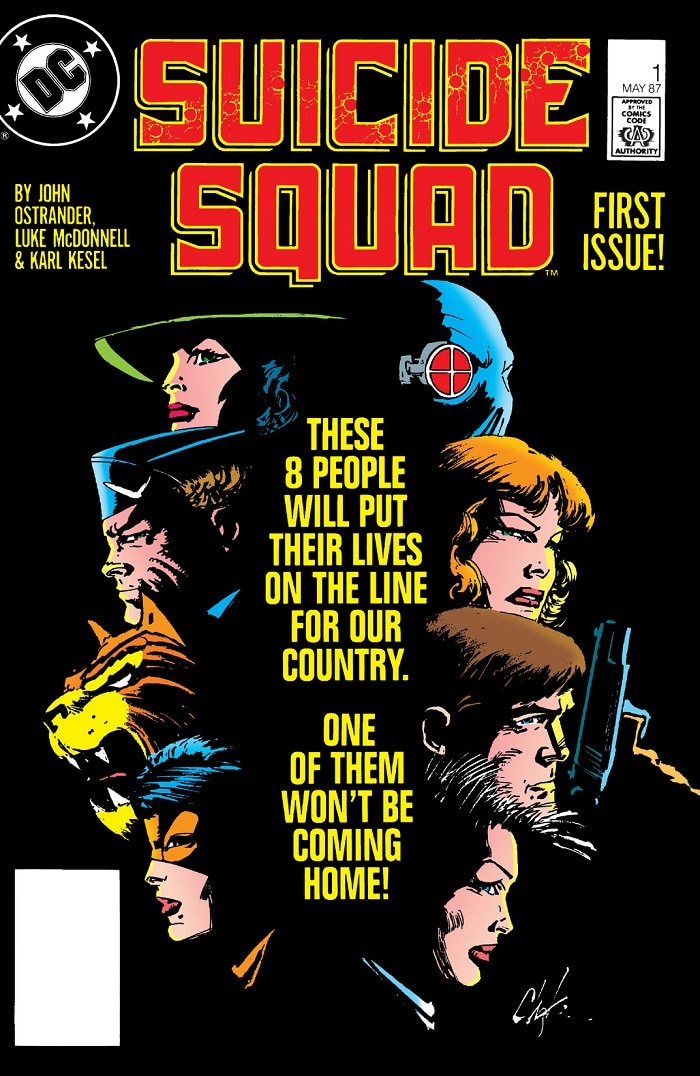
After Secret Society, DC let the concept of the villain-led ongoing lay fallow for a while, until the launch of 1987’s Suicide Squad presented an unbeatable formula: take DC’s vast catalog of incarcerated villains and force them to work for the government. As an ongoing, Suicide Squad got 66 issues in ‘87, twelve issues in 2001, 31 issues in 2011, 23 in 2014, 52 in 2016, eleven in 2009, and most recently fifteen in 2021. It’s just a matter of time before we see them back in action.
One of DC’s biggest breakout villains has been the Teen Titans nemesis Deathstroke the Terminator, who first got his own title in 1991. It ran for an impressive 65 issues, including specials and annuals. He’d get another shot in 2011 with a 21-issue series, in 2014 with another 22 issues, in 2016 with fifty issues, and as the star of Deathstroke Inc. in 2021 for fifteen issues.
After the “Darkness Within” crossover event of 1992, Eclipso got his own ongoing series for nineteen issues.
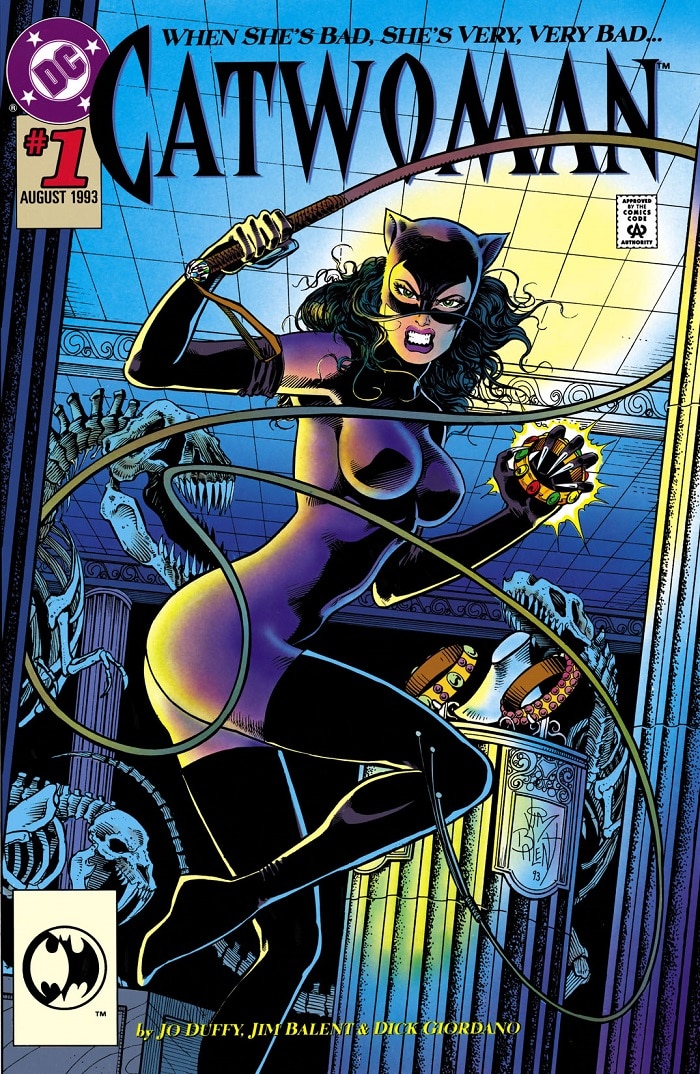
Catwoman, as you mentioned, has a complex history with where she stands in regards to villainy, a fluctuating position which continues to this day. She got her first ongoing series in 1993, which ran for 96 issues—a record holder for DC villains. That was followed by an 83-issue series in 2002, a 52-issue series in 2011, and a currently ongoing title from 2018 which stands at 55 issues and counting.
Lobo is another character who’s gone back and forth across the morality line, but he’s been a villain often as not. He got his first ongoing in 1993 for 66 fraggin’ issues, followed by a sleeker, sexier series in 2014 for another thirteen.
A new version of the Silver Age Atom villain Chronos, Walker Gabriel, debuted in his own ongoing series in 1998. It ran for twelve issues, including a special tie-in to the DC One Million event.
Alan Grant and Norm Breyfogle’s Batman antagonist Anarky got his own miniseries in 1997, which was followed by an ongoing in 1999. It lasted eight issues, four more than his miniseries.
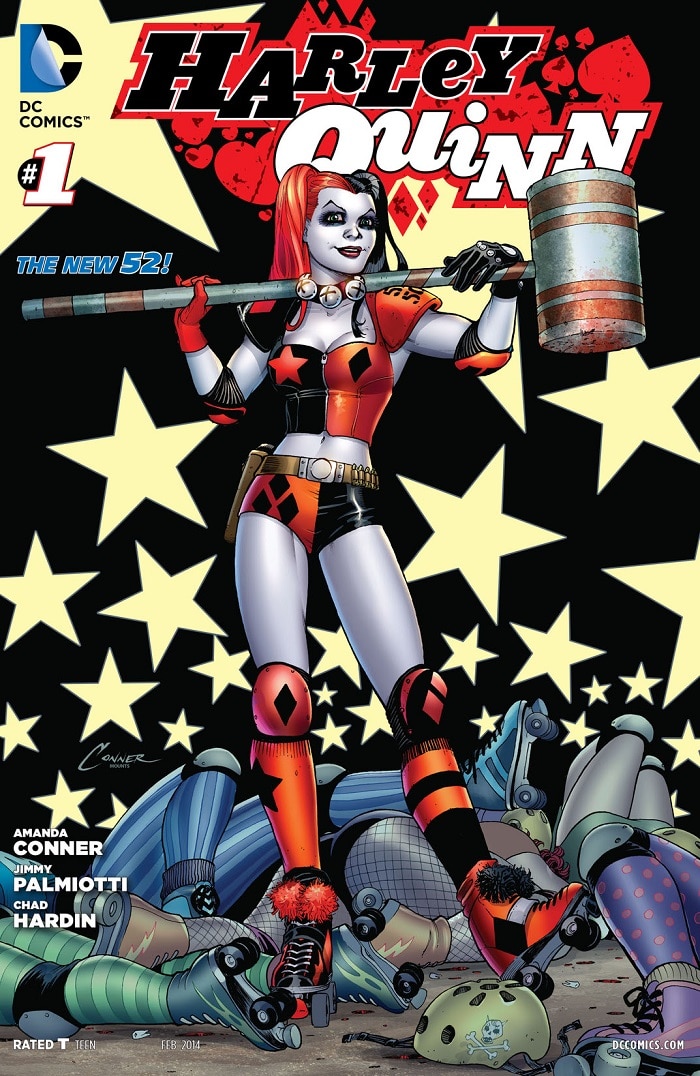
That brings us to Harley Quinn. Harley got a 38-issue series to herself in 2000, followed by thirty issues in 2013, two books in 2016—a main Harley Quinn series which ran 75 issues, and a team-up comic, Harley’s Little Black Book, for six issues—a three-issue digital series, Harley Quinn: Make ‘Em Laugh, and a seventeen-issue digital anthology series, Harley Quinn: Black + White + Red, in 2020, and a relaunched title in 2021 still going strong.
Who’s a more notorious villain in all of our collective cultural mythology than Lucifer? The prince of lies has gotten himself three ongoings under DC’s banner, including 75 issues in 2000, nineteen issues in 2016, and eighteen issues in 2018 under the Sandman Universe banner. Five further issues of that last series were planned, but were released exclusively as a trade paperback.
While we’re talking about Vertigo, Dashiell Bad Horse, protagonist of Jason Aaron and RM Guera’s 2007 Vertigo series Scalped, may not have been a traditional super-villain, but he certainly wasn’t a good person. It ran for sixty issues.
In an unlikely turn of events, the Un-Men, genetic freak minions of Anton Arcane from Swamp Thing, got an ongoing series of their own in 2007. It ran thirteen issues.
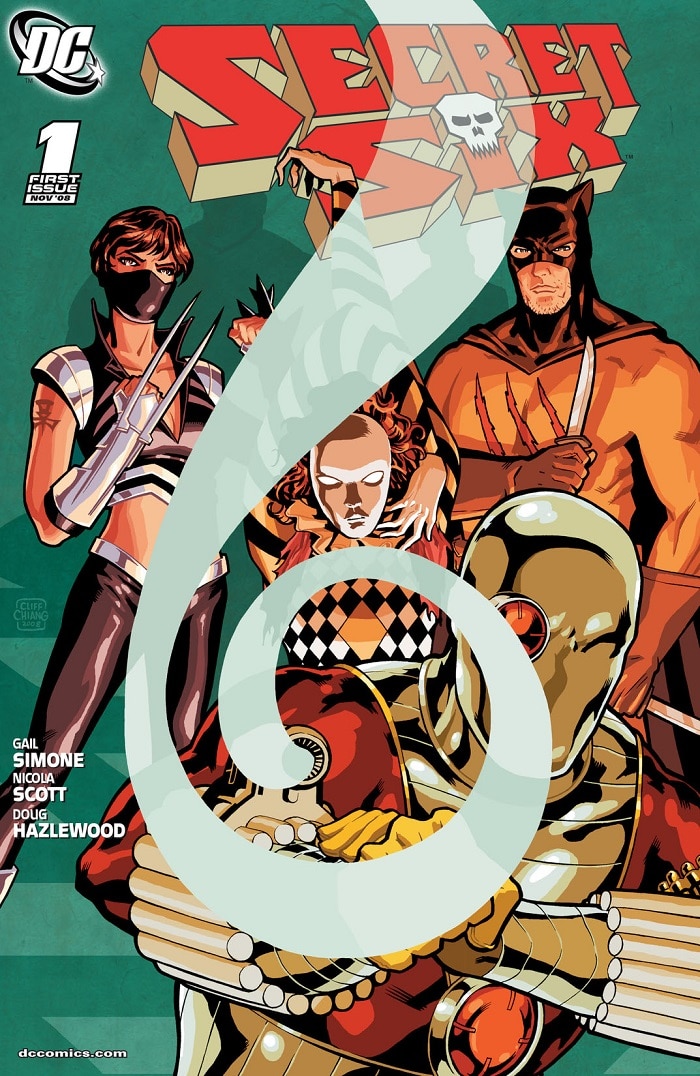
Gail Simone’s treatment of the Secret Six as a team of super-villain rejects for hire has gotten two ongoings of their own, for 36 issues in 2008 and another fourteen in 2014.
It’s hard to say whether you’d count Magog, originally introduced as an antagonist to Superman in Kingdom Come, as a villain, when he’s intended as an archetype of the anti-hero figure. We might as well include him here. He got his own ongoing series in 2009, lasting twelve issues.
In 2009, ongoing veterans Catwoman, Harley Quinn and new ongoing star Poison Ivy received their own team-up book, Gotham City Sirens. Their misadventures lasted 26 issues.
2011’s Voodoo was a title referring to two versions of the same character, though the first we meet is most certainly a villain. The series lasted thirteen issues.
Green Lantern Corps antagonists the Red Lanterns got their own ongoing series in 2011 as a part of the New 52. However, the series didn’t quite make it to 52 issues. (It ended at issue #40.)
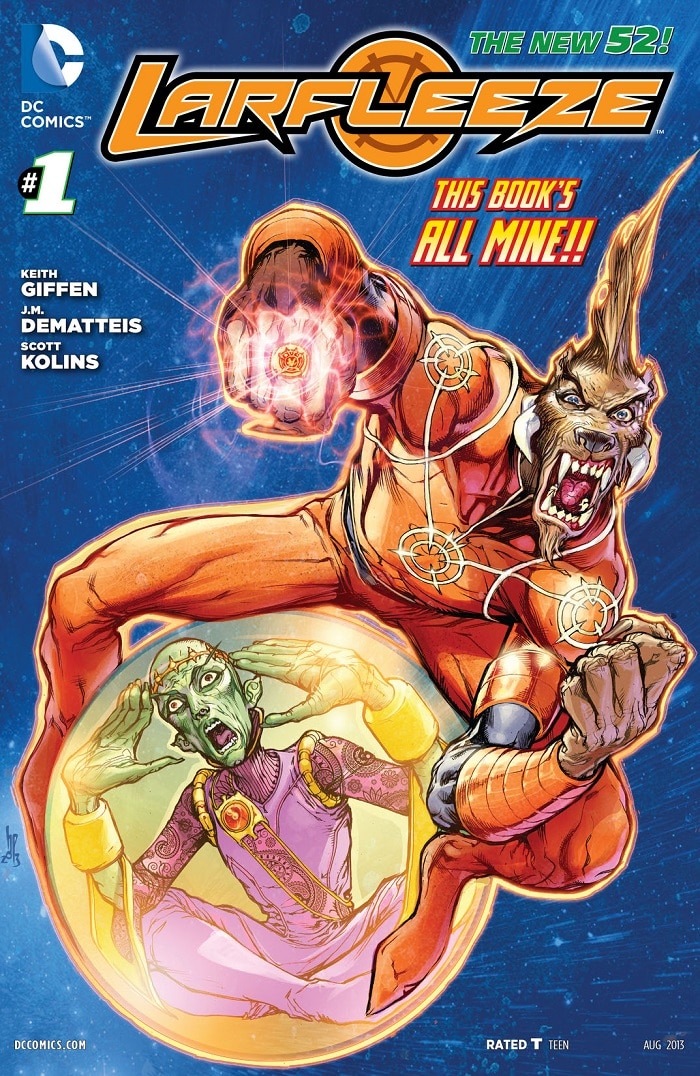
Ongoings for Green Lantern villains were a bit of a thing during the New 52. The next one to score his own ongoing was Larfleeze, with twelve issues in 2013.
Green Lantern’s nemesis Sinestro followed with his own series in 2014, for 23 issues.
Originally an Etrigan villain, Klarion the Witchboy got his own series in 2014 by Ann Nocenti and Trevor McCarthy, with a dynamic new look and a fresh cast of supporting characters. The series ran for six issues.
Telos, introduced as the villain of 2015’s “Convergence” event, set off on his own quest for redemption that same year. It would last six issues.
Poison Ivy would finally get a series of her own in 2022, first launched as a six-issue miniseries before an extension by popular demand to twelve, and currently an indefinite ongoing.
As for our buddy Mr. J, the Joker got a surprise unpublished 10th issue of his 1975 series in print back in 2019. That was followed with a fifteen-issue series in 2021 and 2022’s currently ongoing The Joker: The Man Who Stopped Laughing at eight issues and counting.
Better to Reign
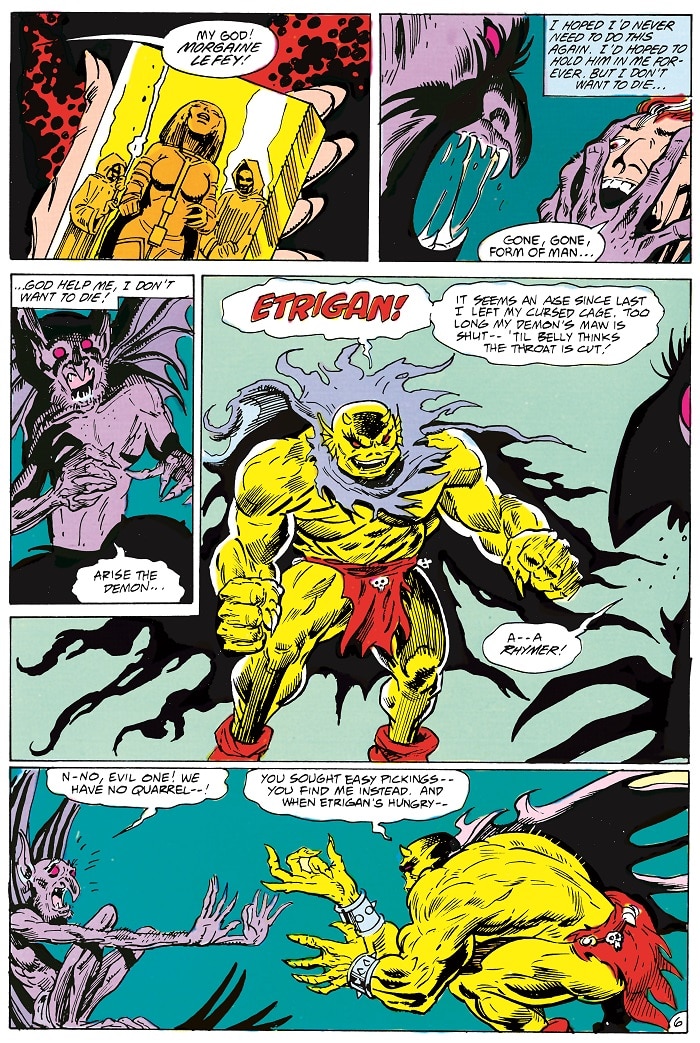
AnuTheWorm asks:
Just got done reading Ennis’ Hellblazer and had a question about a bit of Hell lore mentioned there. During one of his numerous monologues about his own backstory, the First of the Fallen mentions three upheavals that allowed him to take the infernal throne—the attack of the Great Darkness, Lucifer’s resignation and an attempt by Etrigan to seize control after the preceding two. The former incidents are, of course, some of the most famous story arcs from Swamp Thing and Sandman respectively, but did the latter occur in an actual comic? If so, which?
The First of the Fallen here is referring to an ongoing arc chronicling Etrigan’s ascendancy in Action Comics at the time, during its year as a weekly anthology. 1989’s Action Comics #636-#641 (above) show Etrigan’s rise through the ranks of Hell in a six-part story by Alan Grant and Mark Pacella, before culminating in his rise to power as the ruler of Hell in the first seven issues of his own 1990 ongoing series. This prolonged campaign happened to intersect with both Garth Ennis and Neil Gaiman’s own plans for Hell-based storylines in Hellblazer and The Sandman, during a time when the Vertigo line, still in its infancy, was not quite fully separated from ongoing DC continuity. This required Ennis and Gaiman each to acknowledge the storyline in their own fashion. By The Demon #7, Etrigan had been deposed as Hell’s ruler thanks to Merlin, rejoined once more to the soul Jason Blood.
Leave It to Binky
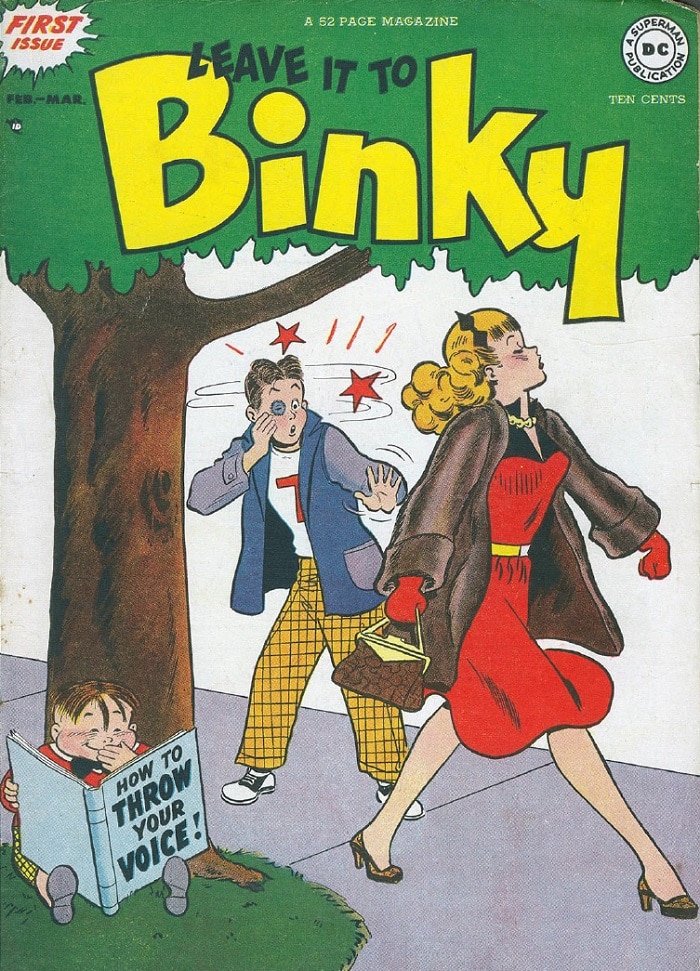
moonknightrider2.98891 asks:
I was reading some background details on Binky recently and the website I was on said that Binky was actually the first DC character to get their own title without first being in an anthology book. This naturally raised the question of which superhero or action character was the first one to get their own title without first being in an anthology book. Was it Rex, the Wonder Dog, as I suspect?
Your Binky information is correct. One might argue an exception for Jay Garrick, who first appeared in Flash Comics #1, but though the book bore his name, it was still an anthology title. Binky first appeared in 1948’s Leave it to Binky #1, which continued for 71 issues.
After him came Miss Beverly Hills of Hollywood in 1949, which lasted nine issues. Then Miss Melody Lane of Broadway in 1950, for 3 issues. The next DC character to debut in their own solo title was indeed Rex the Wonder Dog in 1952, though he was followed soon after that same year by The Phantom Stranger.
Constructive Feedback
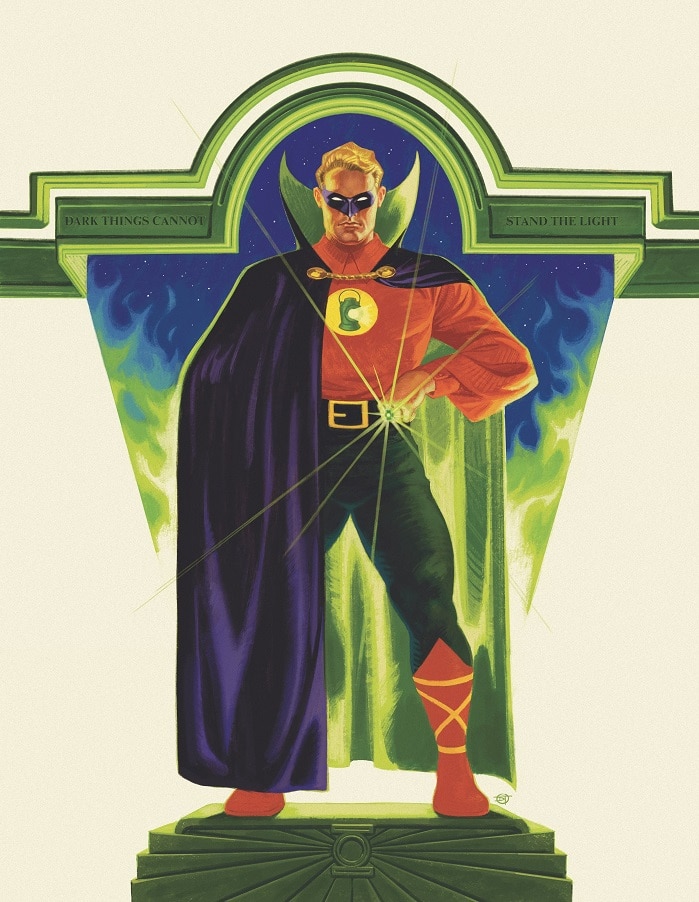
KookieSuperApe asks:
Originally, in the Golden Age, Alan Scott’s Green Lantern ring “merely” granted him superpowers and shot out light beams and green flame, but he didn’t make imaginative constructs with it. So, when was the first time that a Green Lantern made a construct with their ring? And when was the first time that Alan Scott specifically made a construct with his ring?
Let’s try to define a construct here as the generation of a solid object made from light—now the main expression of Green Lantern’s powers. Something to this effect first occurs in Alan’s second appearance in 1940’s All-American Comics #17, where he uses his ring to generate a wall of light.
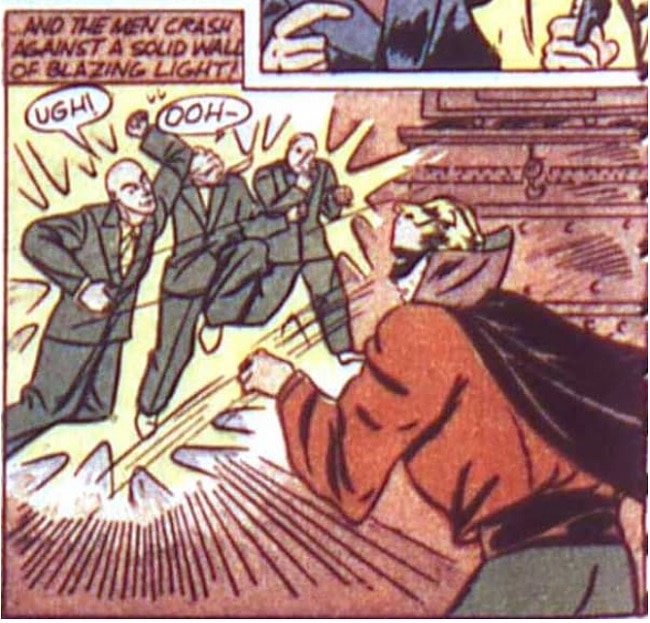
Alan uses the “wall of light” trick as a stand-by many times after that in his early adventures. The constructs get a little more advanced with 1942’s All-American Comics #43, when he generates cushions to catch the fall of a man carrying dynamite.
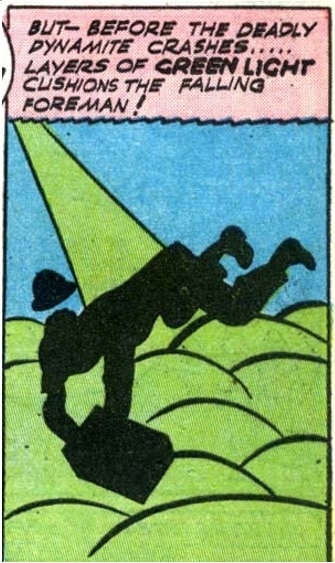
In 1943’s Green Lantern #7, Alan Scott uses his ring as a sort of rudimentary laser sword:
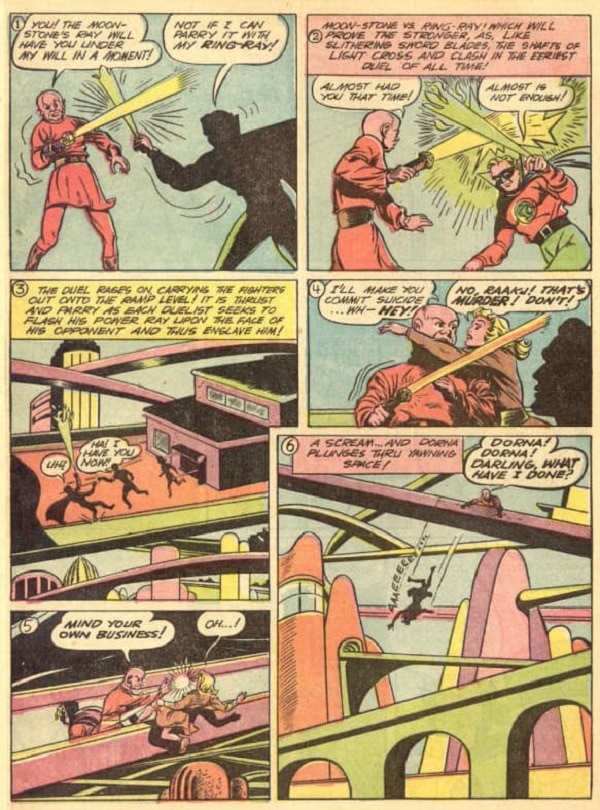
Green Lantern #13 sees Alan use his ring to make an abstract light bridge:
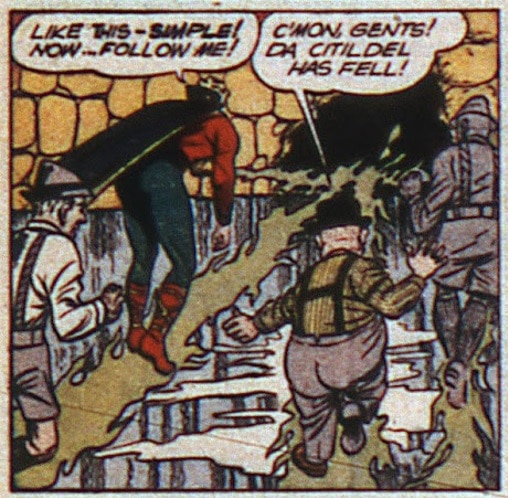
In 1944’s Comic Cavalcade #8, Alan Scott uses his ring as a lasso to round up a group of criminals. Like his “wall of light,” the rope would become part of his ring’s repertoire from then on.
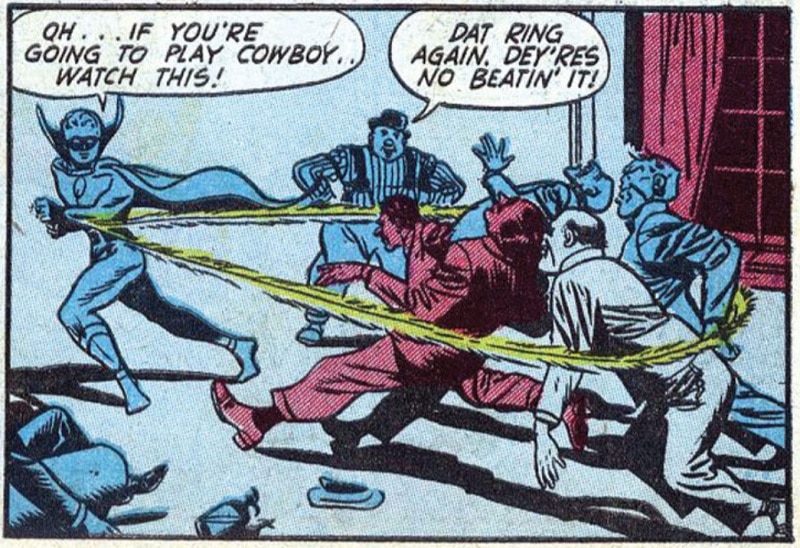
We get our first genuine, representational construct in 1945’s Comic Cavalcade #11, 88 issues after his first appearance in All-American Comics #16, where Alan projects fists to punch out some enemies. Alan continues to manifest hands, and eventually still further complex objects, from there.
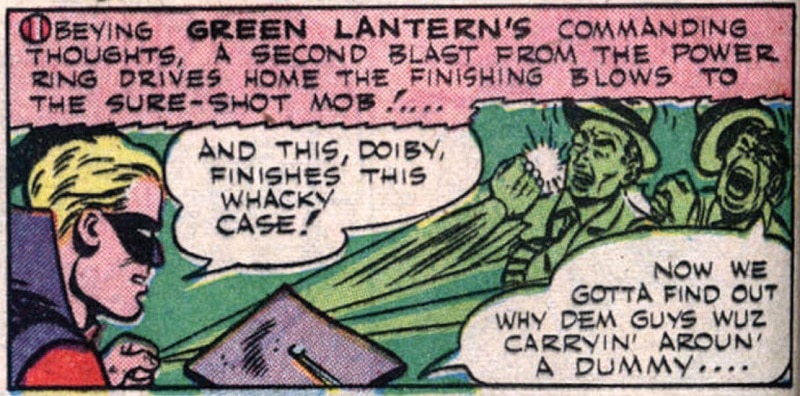
And this, Doiby, finishes this whacky case! Make sure you find me in the DC Community to ask me anything else you’d like to know about our vast library and all its twisting passages. It never hurts to ASK…THE QUESTION.
Alex Jaffe is the author of our monthly "Ask the Question" column and writes about TV, movies, comics and superhero history for DC.com. Follow him on Twitter at @AlexJaffe and find him in the DC Community as HubCityQuestion.
NOTE: The views and opinions expressed in this column are solely those of Alex Jaffe and do not necessarily reflect those of DC Entertainment or Warner Bros., nor should they be read as confirmation or denial of future DC plans.

